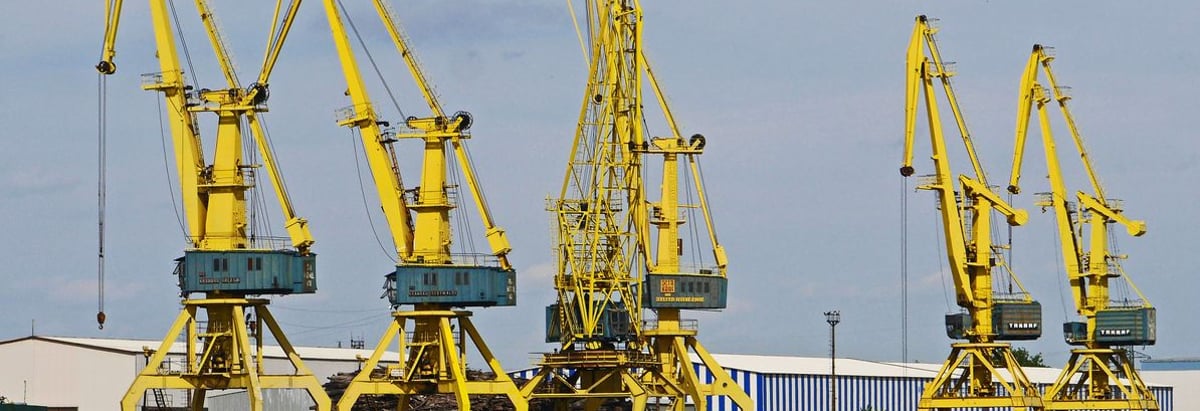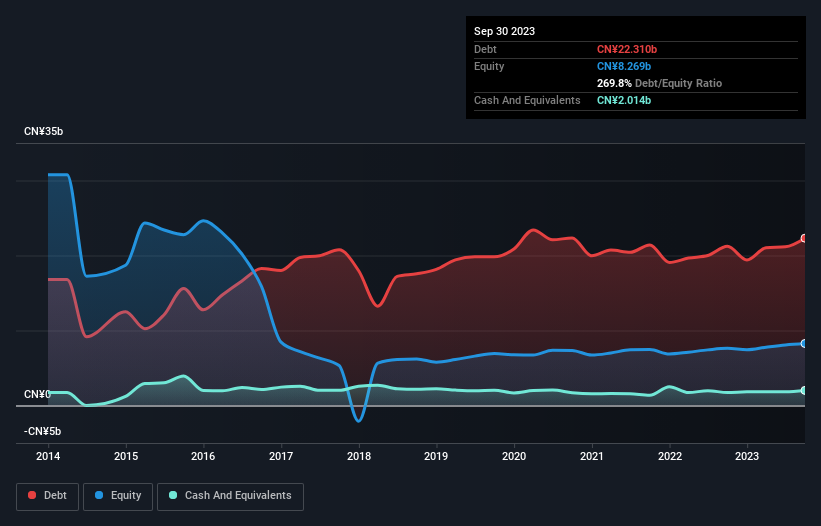- Hong Kong
- /
- Energy Services
- /
- SEHK:1033
Does Sinopec Oilfield Service (HKG:1033) Have A Healthy Balance Sheet?

Warren Buffett famously said, 'Volatility is far from synonymous with risk.' It's only natural to consider a company's balance sheet when you examine how risky it is, since debt is often involved when a business collapses. Importantly, Sinopec Oilfield Service Corporation (HKG:1033) does carry debt. But is this debt a concern to shareholders?
When Is Debt Dangerous?
Debt is a tool to help businesses grow, but if a business is incapable of paying off its lenders, then it exists at their mercy. In the worst case scenario, a company can go bankrupt if it cannot pay its creditors. However, a more usual (but still expensive) situation is where a company must dilute shareholders at a cheap share price simply to get debt under control. Of course, plenty of companies use debt to fund growth, without any negative consequences. When we think about a company's use of debt, we first look at cash and debt together.
View our latest analysis for Sinopec Oilfield Service
How Much Debt Does Sinopec Oilfield Service Carry?
You can click the graphic below for the historical numbers, but it shows that as of September 2023 Sinopec Oilfield Service had CN¥22.3b of debt, an increase on CN¥21.2b, over one year. However, because it has a cash reserve of CN¥2.01b, its net debt is less, at about CN¥20.3b.

A Look At Sinopec Oilfield Service's Liabilities
We can see from the most recent balance sheet that Sinopec Oilfield Service had liabilities of CN¥65.2b falling due within a year, and liabilities of CN¥1.11b due beyond that. On the other hand, it had cash of CN¥2.01b and CN¥35.5b worth of receivables due within a year. So it has liabilities totalling CN¥28.8b more than its cash and near-term receivables, combined.
Given this deficit is actually higher than the company's market capitalization of CN¥27.1b, we think shareholders really should watch Sinopec Oilfield Service's debt levels, like a parent watching their child ride a bike for the first time. Hypothetically, extremely heavy dilution would be required if the company were forced to pay down its liabilities by raising capital at the current share price.
We use two main ratios to inform us about debt levels relative to earnings. The first is net debt divided by earnings before interest, tax, depreciation, and amortization (EBITDA), while the second is how many times its earnings before interest and tax (EBIT) covers its interest expense (or its interest cover, for short). This way, we consider both the absolute quantum of the debt, as well as the interest rates paid on it.
While Sinopec Oilfield Service's debt to EBITDA ratio (4.2) suggests that it uses some debt, its interest cover is very weak, at 2.3, suggesting high leverage. In large part that's due to the company's significant depreciation and amortisation charges, which arguably mean its EBITDA is a very generous measure of earnings, and its debt may be more of a burden than it first appears. So shareholders should probably be aware that interest expenses appear to have really impacted the business lately. Looking on the bright side, Sinopec Oilfield Service boosted its EBIT by a silky 81% in the last year. Like the milk of human kindness that sort of growth increases resilience, making the company more capable of managing debt. There's no doubt that we learn most about debt from the balance sheet. But ultimately the future profitability of the business will decide if Sinopec Oilfield Service can strengthen its balance sheet over time. So if you're focused on the future you can check out this free report showing analyst profit forecasts.
Finally, while the tax-man may adore accounting profits, lenders only accept cold hard cash. So the logical step is to look at the proportion of that EBIT that is matched by actual free cash flow. Happily for any shareholders, Sinopec Oilfield Service actually produced more free cash flow than EBIT over the last three years. There's nothing better than incoming cash when it comes to staying in your lenders' good graces.
Our View
Sinopec Oilfield Service's conversion of EBIT to free cash flow was a real positive on this analysis, as was its EBIT growth rate. In contrast, our confidence was undermined by its apparent struggle to cover its interest expense with its EBIT. When we consider all the factors mentioned above, we do feel a bit cautious about Sinopec Oilfield Service's use of debt. While debt does have its upside in higher potential returns, we think shareholders should definitely consider how debt levels might make the stock more risky. There's no doubt that we learn most about debt from the balance sheet. But ultimately, every company can contain risks that exist outside of the balance sheet. For instance, we've identified 1 warning sign for Sinopec Oilfield Service that you should be aware of.
When all is said and done, sometimes its easier to focus on companies that don't even need debt. Readers can access a list of growth stocks with zero net debt 100% free, right now.
New: Manage All Your Stock Portfolios in One Place
We've created the ultimate portfolio companion for stock investors, and it's free.
• Connect an unlimited number of Portfolios and see your total in one currency
• Be alerted to new Warning Signs or Risks via email or mobile
• Track the Fair Value of your stocks
Have feedback on this article? Concerned about the content? Get in touch with us directly. Alternatively, email editorial-team (at) simplywallst.com.
This article by Simply Wall St is general in nature. We provide commentary based on historical data and analyst forecasts only using an unbiased methodology and our articles are not intended to be financial advice. It does not constitute a recommendation to buy or sell any stock, and does not take account of your objectives, or your financial situation. We aim to bring you long-term focused analysis driven by fundamental data. Note that our analysis may not factor in the latest price-sensitive company announcements or qualitative material. Simply Wall St has no position in any stocks mentioned.
About SEHK:1033
Sinopec Oilfield Service
Provides petroleum engineering and technology services.
Proven track record with moderate growth potential.
Similar Companies
Market Insights
Community Narratives




